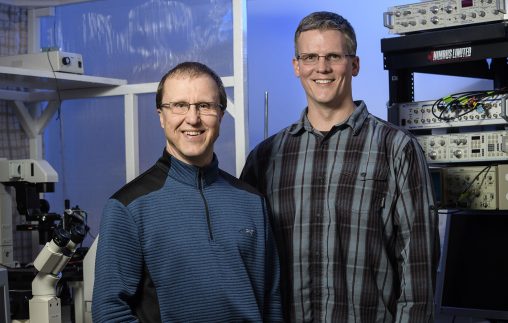
Mark Rich, professor of neurology and neuroscience, cell biology and physiology, left; and Andrew Voss, associate professor of biological sciences. (Photo by Erin Pence)
Finding new treatments for people who suffer temporary paralysis and other muscle diseases is the hope of Wright State University researchers who have been awarded $2.7 million in federal grant money to study electrical signaling in the body.
“I think new treatments for these patients is a likely outcome,” said Mark Rich, professor of neurology in the Boonshoft School of Medicine and professor of neuroscience, cell biology and physiology in the College of Science and Mathematics. “But there is also a possibility we’ll figure things out that have a wider implication.”
Rich and Andrew Voss, associate professor of biological sciences, have been awarded a five-year grant from the National Institute of Arthritis and Musculoskeletal and Skin Diseases and some additional funding from the Muscular Dystrophy Association. Their research project is titled “Novel Approaches to Therapy of Muscle Ion Channelopathies.”
Electrical signals produced by the body cause muscles to contract or flex and are essential for movement. The larger electrical currents — generated by proteins such as sodium and potassium channels — have been extensively studied over the past 50 years, but the smaller currents are much less understood.
“Even though the currents are smaller, they play crucial roles in regulating the firing of muscle when you do longer contractions,” said Rich. “If I want to keep my muscle contracting, I’m repeatedly having to fire electrical signals over and over. And when you do that, these smaller currents become very important.”
Rich said treating patients by blocking the main electrical channels is like using a sledgehammer and can risk paralyzing the muscle. Being able to regulate the smaller currents holds out the promise of more targeted and effective treatments.
“These currents are hard to find,” said Rich. “That’s why they’ve been missed.”
Voss likens it to looking at the foundation of a skyscraper instead of focusing on the upper stories.
“Dr. Rich will measure the overall muscle properties and we’re going to be looking for the small currents,” said Voss. “My lab is good at going in and measuring those currents.”
Disorders of muscle electric signaling include periodic paralyses in which patients become paralyzed for minutes to hours or where the muscles become too stiff for movement.
“These are rare diseases, but can be devastating for those affected,” said Rich.
Rich said the research may also shed new light on how electrical currents work in the normal muscle.
“We may figure out some things about how normal muscles work and how they affect a wider range of diseases,” he said.
The two researchers have already had success measuring small currents in isolated muscle, as reported in the Annals of Neurology, and are working to extend that work to the whole animal. That will be necessary before they move on to clinical studies with human patients.
Rich grew up in Kansas, where his father taught chemistry at Bethel College, and later in Tokyo, where his father taught at the prestigious International Christian University.
Rich earned his bachelor’s degree in chemistry and biology from Bethel College in 1983 and his medical/Ph.D. degree from Washington University in St. Louis in 1989. He completed his neurology residency at Johns Hopkins University in 1993, a neuromuscular fellowship at the University of Pennsylvania in 1998 and then worked as an assistant professor at Emory University.
Rich joined the faculty at Wright State in 2005 and is currently co-director of neurology/psychiatry/muscular-skeletal course for second-year medical students at the Boonshoft School of Medicine.

 Milling around
Milling around  Wright State recognizes Nursing Professor Kim Ringo for advancing international student success
Wright State recognizes Nursing Professor Kim Ringo for advancing international student success  Wright State honors graduating students for distinguished doctoral dissertations
Wright State honors graduating students for distinguished doctoral dissertations  Top 10 Newsroom videos of 2025
Top 10 Newsroom videos of 2025  Museum-quality replica of historic Hawthorn Hill donated to Wright State
Museum-quality replica of historic Hawthorn Hill donated to Wright State 